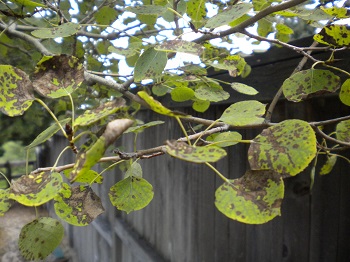There are various types of diseases trees and plants can suffer from. The aspen and cottonwood trees around Northern Colorado aren’t looking as beautiful as they once did. This is due to a leaf
It’s worth understanding what’s causing these leaf diseases. This will help you care for your own trees and know what to do to help prevent the spread onto other trees.
What Is Causing the Leaf Spot Diseases?
Aspens and cottonwoods are suffering from leaf spot diseases. They’re due to the wetter springs and summers we’re getting, and the dampness leads to the growth of two fungal infections in the trees. We know what fungal infections are like on a person and how they grow; they same applies to trees.
Marssonina is caused by the Marssonina fungus. This is the fungus that is infecting the aspens and some of the cottonwoods. Other cottonwoods (mostly) are being infected by Septoria fungus.
What Does the Damage Look Like?
You’ll know if your aspens are infected by the Marssonina fungus. The disease leads to brown spots and flecks around the leaves. This can turn into black splotches when the infection becomes more severe.
The leaves with the spots will also look less vibrant. Some of the leaves will drop early, which does lead to a change in the way an area looks. The good news is there are usually plenty of healthy trees so the infection isn’t as noticeable at a glance.
How Much Damage Is Caused?
There is a little bit of good news when it comes to the fungal disease. It doesn’t mean you have to cut the tree down. This disease doesn’t cause permanent damage to the tree in the majority of cases. The downside is that there can be some defoliation on the impacted trees. Most of the damage is just aesthetic damage, but it’s important to keep an eye on the overall health of the tree.
However, there are concerns about how high the levels of the disease are right now. It’s a sign of how the climate is changing. This can mean that it’s harder to keep the outbreaks under control to prevent more serious damage.
It is worth using some fungicide sprays to help prevent the infection. These sprays need to be used in the spring, but only on trees that haven’t been infected. Those already infected don’t have a cure, and it’s important to just wait it out. You’ll want to keep the leaves and twigs as dry as possible to help reduce the risk of the infection coming back the next year.

